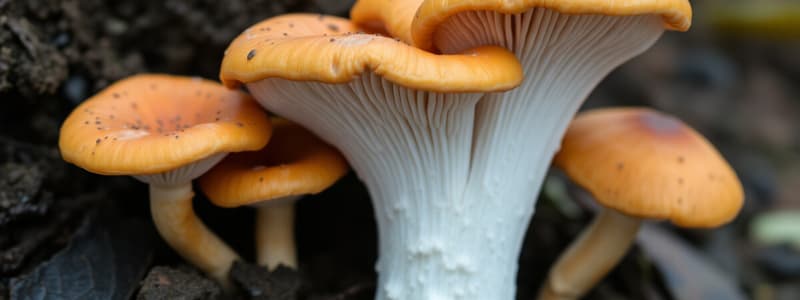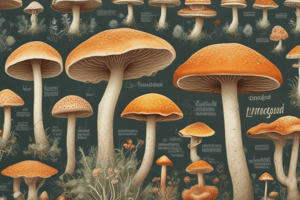Podcast
Questions and Answers
What process involves the fusion of two compatible hyphae leading to a dikaryotic mycelium?
What process involves the fusion of two compatible hyphae leading to a dikaryotic mycelium?
- Karyogamy
- Budding
- Meiosis
- Plasmogamy (correct)
Which of the following is a method of asexual reproduction in fungi?
Which of the following is a method of asexual reproduction in fungi?
- Meiosis
- Karyogamy
- Plasmogamy
- Budding (correct)
What role do fungi play in ecosystems as decomposers?
What role do fungi play in ecosystems as decomposers?
- Producing antibiotics
- Breaking down dead organic matter (correct)
- Contributing to mycorrhizal networks
- Creating complex carbohydrates
What is the result of karyogamy in fungi?
What is the result of karyogamy in fungi?
Which type of relationship is formed between mycorrhizae fungi and plant roots?
Which type of relationship is formed between mycorrhizae fungi and plant roots?
What substance do yeasts provide in the baking process?
What substance do yeasts provide in the baking process?
What is a potential effect of fungal pathogens on agriculture?
What is a potential effect of fungal pathogens on agriculture?
What is one of the abilities of fungi utilized in bioremediation?
What is one of the abilities of fungi utilized in bioremediation?
Which of the following organisms are included in lichens?
Which of the following organisms are included in lichens?
What does fragmentation in fungi refer to?
What does fragmentation in fungi refer to?
What type of hyphae do Glomeromycetes have?
What type of hyphae do Glomeromycetes have?
Which reproductive strategy involves the fusion of specialized hyphae?
Which reproductive strategy involves the fusion of specialized hyphae?
What is a key characteristic of morphological classification in fungi?
What is a key characteristic of morphological classification in fungi?
Which type of mycorrhizae is formed by Basidiomycetes and Ascomycetes?
Which type of mycorrhizae is formed by Basidiomycetes and Ascomycetes?
What role do saprotrophic fungi play in ecosystems?
What role do saprotrophic fungi play in ecosystems?
Which of the following is a characteristic of genetic classification in fungi?
Which of the following is a characteristic of genetic classification in fungi?
What is a significant impact of fungal pathogens on agriculture?
What is a significant impact of fungal pathogens on agriculture?
Which fungi are the source of the antibiotic penicillin?
Which fungi are the source of the antibiotic penicillin?
What do lichens consist of?
What do lichens consist of?
Which fungal group includes water molds?
Which fungal group includes water molds?
What is a primary role of Chytridiomycota in the environment?
What is a primary role of Chytridiomycota in the environment?
What characteristic defines Ascomycetes?
What characteristic defines Ascomycetes?
What adaptation helps fungi withstand environmental stresses?
What adaptation helps fungi withstand environmental stresses?
Which of these fungi are known for forming a zygosporangium?
Which of these fungi are known for forming a zygosporangium?
What is a common fungal infection that affects human skin?
What is a common fungal infection that affects human skin?
What type of organisms do Glomeromycetes primarily engage with?
What type of organisms do Glomeromycetes primarily engage with?
Which of the following groups of fungi is primarily associated with producing mushrooms?
Which of the following groups of fungi is primarily associated with producing mushrooms?
Which type of fungal reproduction involves the formation of conidia?
Which type of fungal reproduction involves the formation of conidia?
Which of the following statements about fungi is true?
Which of the following statements about fungi is true?
Which group of fungi is considered the most primitive?
Which group of fungi is considered the most primitive?
Flashcards are hidden until you start studying
Study Notes
Fungi Reproduction
- Fungi can reproduce both sexually and asexually.
- Asexual reproduction involves the production of spores, budding, and fragmentation.
- Sexual reproduction involves plasmogamy (fusion of hyphae), karyogamy (fusion of nuclei), and meiosis (producing haploid spores).
Ecological Roles
- Fungi are essential decomposers, breaking down dead organic matter and recycling nutrients.
- They form symbiotic relationships like mycorrhizae (fungi and plant roots) and lichens (fungi and algae/cyanobacteria).
- Some fungi are pathogens, causing diseases in plants, animals, and humans.
Fungal Evolution
- Believed to have originated around 1.5 billion years ago.
- More closely related to animals than plants.
- Early fungi were likely simple, aquatic organisms resembling modern chytrids.
- As fungi adapted to terrestrial environments, they evolved a chitin cell wall for structural support and protection.
Major Fungal Groups
- Chytridiomycota (Chytrids): Most primitive, predominantly aquatic, with motile spores (flagellated).
- Zygomycota (Zygomycetes): Terrestrial fungi known for decomposing organic matter, forming zygosporangia during sexual reproduction.
- Ascomycota (Ascomycetes): Largest and diverse group, producing spores in sac-like asci. Includes yeasts, molds, and morels.
- Basidiomycota (Basidiomycetes): Produce spores on a basidium, includes mushrooms, puffballs, and shelf fungi. Important decomposers and mycorrhizal partners.
- Glomeromycota (Glomeromycetes): Form arbuscular mycorrhizae with plant roots for nutrient uptake.
Fungal Classification
- Morphological Classification: Physical characteristics like hyphal structure (septate or coenocytic), reproductive structures, and spore characteristics.
- Reproductive Classification: Based on sexual and asexual reproduction strategies.
- Genetic Classification: Using molecular techniques to analyze genetic relationships (e.g., rRNA sequences).
Applications of Fungi
- Medicine: Source of antibiotics (penicillin), immunosuppressants (cyclosporine), and antifungals.
- Agriculture: Used for biocontrol of pests and diseases in crops.
Fungal Diseases
- Plant Diseases: Rusts, smuts, and blights can cause significant crop losses.
- Animal Diseases: Fungi can cause ringworm and systemic infections in animals.
- Human Infections: Range from superficial (athlete's foot) to systemic (in immunocompromised individuals).
Studying That Suits You
Use AI to generate personalized quizzes and flashcards to suit your learning preferences.




